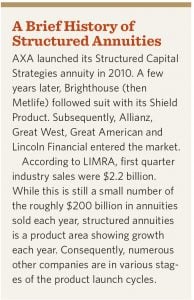Today, registered index-linked annuities, buffered annuities, index-linked variable annuities and structured annuities are all used to describe a single product. Given the many names for this relatively new annuity structure, I suspect there is some confusion as to what these products are and when they should be recommended.
I refer to these products as structured annuities because the insurance industry based the design on structured notes offered by most broker-dealers. Structured notes are bank debt obligations that return principal plus interest linked to underlying markets while still providing some downside protection. Structured annuities are similar to structured notes, but offer the potential for tax-deferred growth.
(Related: Why Do People Hate Immediate Annuities?)
How do they compare to other annuities? Let’s start with what they are and what they are not. Like an indexed annuity, the return during the selected period is tied to a particular index, such as the S&P 500 or the MSCI EAFE.
However, structured annuities allow the policyholder to capture much more of the upside of the index than an indexed annuity. Of course, this can’t happen without a tradeoff. Unlike an indexed annuity, a structured annuity merely protects some of the downside and can cause a policyholder to lose money, similar to a variable annuity.
When initially investing in this product, all structured annuities require the policyholder to make three choices that are essentially the same as an indexed annuity: 1) The duration of the interest crediting segment, typically from one to six years; 2) the index used to determine account value performance (e.g., S&P 500, MSCI EAFE, etc.); and 3) the crediting method, which entails the following:
A cap on earnings: Performance is limited to a certain amount of the underlying index return. For example, with a 95% cap on performance, policyholders will receive positive returns up to 95% over the life of the product. So if the index returned 60%, the policyholder would receive 60%, but if the index returned 110% over the life of the product, the policyholder would receive 95% (the cap).
A trigger or step rate: Policyholders receive a specific, predetermined return if the underlying index is either up or unchanged from its initial level. For instance, if the trigger or step rate is 6% and the client selects the S&P 500 index, then the client will receive 6% as long as the S&P 500 is not lower than its initial level during the selected term.
A spread or annual fee deducted to calculate the final return: Like an indexed annuity, some structured annuities offer options that have higher participation rates in exchange for an annual fee or spread. This additional cost is deducted from any gains. The idea behind this approach is to provide more upside in the years where the index performs well above historic averages.
Policyholders essentially pay for this privilege by accepting lower returns in the years where the index is positive but below historic averages. For instance, with a 1.25% annual fee or spread on any gains, if an underlying index returned 5%, the policyholder would receive 3.75% of that gain. If the index returned 20%, the policyholder would receive 18.75%.
Over the long run, back testing would indicate the fee or spread options should provide a boost on the overall average return depending on the index performance. (Please note: past performance is not an indication of future results.) However, it will also lead to a wider expected range of possible returns.
The actual return will be based on the selected index over the selected time period, subject to the limit on the upside, just like an indexed annuity.
Types of Downside Protection
Unlike an indexed annuity, though, structured annuities require the policyholder to choose the amount and type of downside protection. The more downside protection the policyholder elects, the less potential upside they will receive. Typically, structured annuities will offer two methods of limiting downside exposure.
1. “Buffer” against a loss. Structured annuities typically offer a “buffer” of 10%, 20%, or 30%. This percentage represents the total amount of downside protection.
For example, if the policyholder selects a 10% buffer, then the policyholder is protected against any loss as long as the chosen index does not decline more than 10%. To elaborate, if the index over the selected period returned -15%, the policyholder would incur a loss of 5%. Similarly, if the policyholder selects a 20% buffer, then no loss occurs unless the index returns a loss of more than 20%. Not surprisingly, the larger the buffer, the lower the upside potential.









 October 25, 2018 at 12:00 PM
October 25, 2018 at 12:00 PM








 When Should You Consider a Structured Annuity?
When Should You Consider a Structured Annuity?